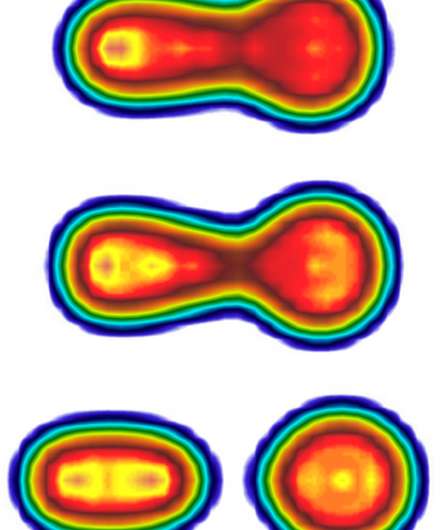Novel model illustrates the finer details of nuclear fission

For nearly 80 years, nuclear fission has awaited a description within a microscopic framework. In the first study of its kind, scientists collaborating from the University of Washington, Warsaw University of Technology (Poland), Pacific Northwest National Laboratory, and Los Alamos National Laboratory, developed a novel model to take a more intricate look at what happens during the last stages of the fission process. Using the model, they determined that fission fragments remain connected far longer than expected before the daughter nuclei split apart. Moreover, they noted the predicted kinetic energy agreed with results from experimental observations. This discovery indicates that complex calculations of real-time fission dynamics without physical restrictions are feasible and opens a pathway to a theoretical microscopic framework with abundant predictive power.
In addition to its publication, "Induced Fission of 240Pu Within a Real-time Microscopic Framework" was highlighted as an Editors' Suggestion by Physical Review Letters—ranked first among physics and mathematics journals by the Google Scholar five-year h-index. Only about one letter in six is highlighted based on its particular importance, innovation, and broad appeal.
Apart from its fundamental significance in theoretical physics, providing a usable capability that can accurately model fission dynamics will impact research areas such as future reactor fuel compositions, nuclear forensics, and studies of nuclear reactions. Excitation energies of fission fragments are not directly accessible by experiments but are crucial inputs to key activities at National Nuclear Security Administration laboratories. The capability developed by this research stands to improve activities that depend upon empirical data and evaluation models by aligning these with predictive theory.
The researchers extended the density functional theory (DFT) modeling method designed for electronic structure systems to strongly interacting many-fermion systems and real-time dynamics, creating a time-dependent superfluid local density approximation (TDSLDA). For the study reported, evaluating the theory amounted to solving ≈56,000 complex coupled nonlinear, time-dependent, three-dimensional partial differential equations for a 240Pu nucleus using a highly efficient parallelized graphic processing unit (GPU) code. The calculations required ≈1760 GPUs and 550 minutes total wall time on Titan, a Cray XK7 supercomputer located at the Oak Ridge Leadership Computing Facility (OLCF).
Unlike other models that incorporate a nuclear energy density functional, the TDSLDA is the only theoretical framework that allows the nucleus to evolve non-adiabatically while including all known collective degrees of freedom. The potential and kinetic energies remain a continuous function of the nuclear shape with no restrictions.
"One notable discovery in using the framework was the time it takes a nucleus to descend to the scission configuration—timescales an order of magnitude greater than those predicted in existing literature," explained co-author Kenneth Roche, a scientist in PNNL's High Performance Computing Group and an Affiliate Associate Professor with the University of Washington, Department of Physics. "One might expect this slow evolution was due to viscosity, but the simulations suggest that many shape and pairing modes are excited, causing energy exchanges in the collective degrees of freedom."
In their article, the authors note that their method could be extended to two-body observables within the fission process, including mass and charge, and eventually, they may be able to introduce additional random aspects that will result in more detailed information.
More information: Aurel Bulgac et al. Induced Fission of within a Real-Time Microscopic Framework , Physical Review Letters (2016). DOI: 10.1103/PhysRevLett.116.122504
Journal information: Physical Review Letters
Provided by Pacific Northwest National Laboratory





















